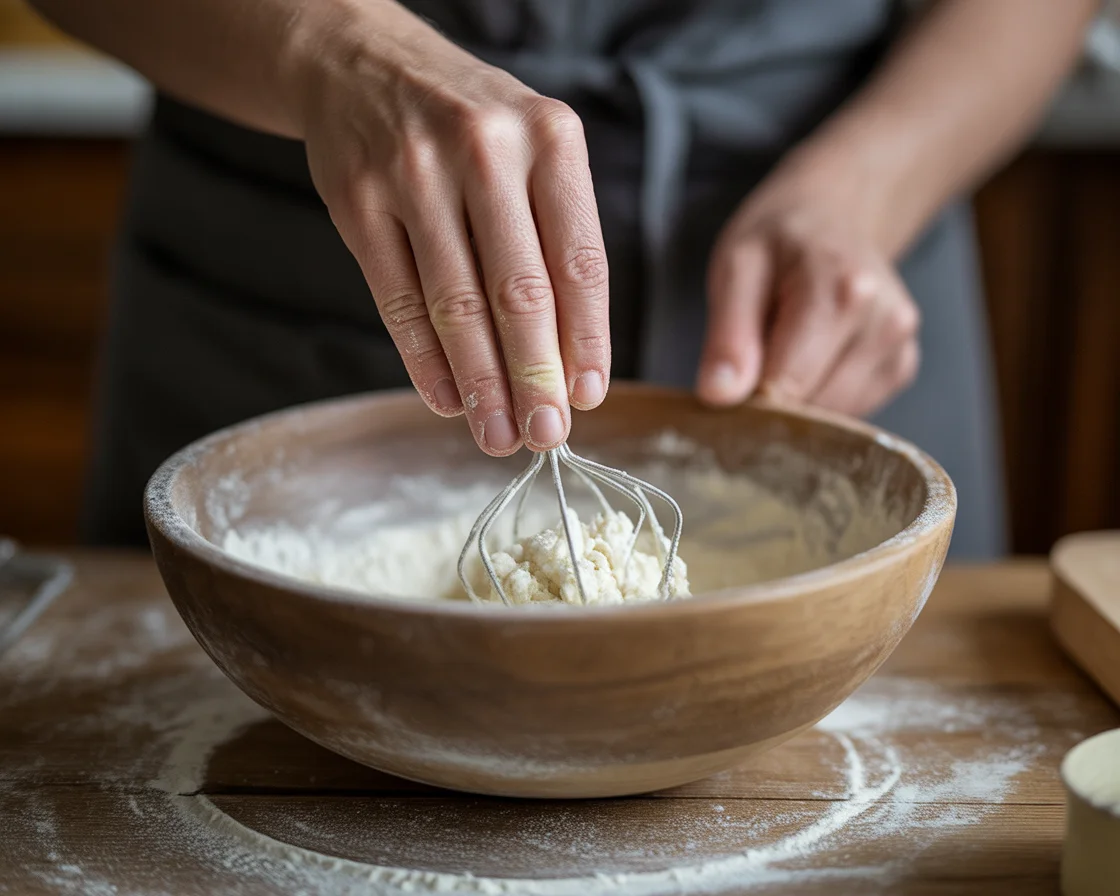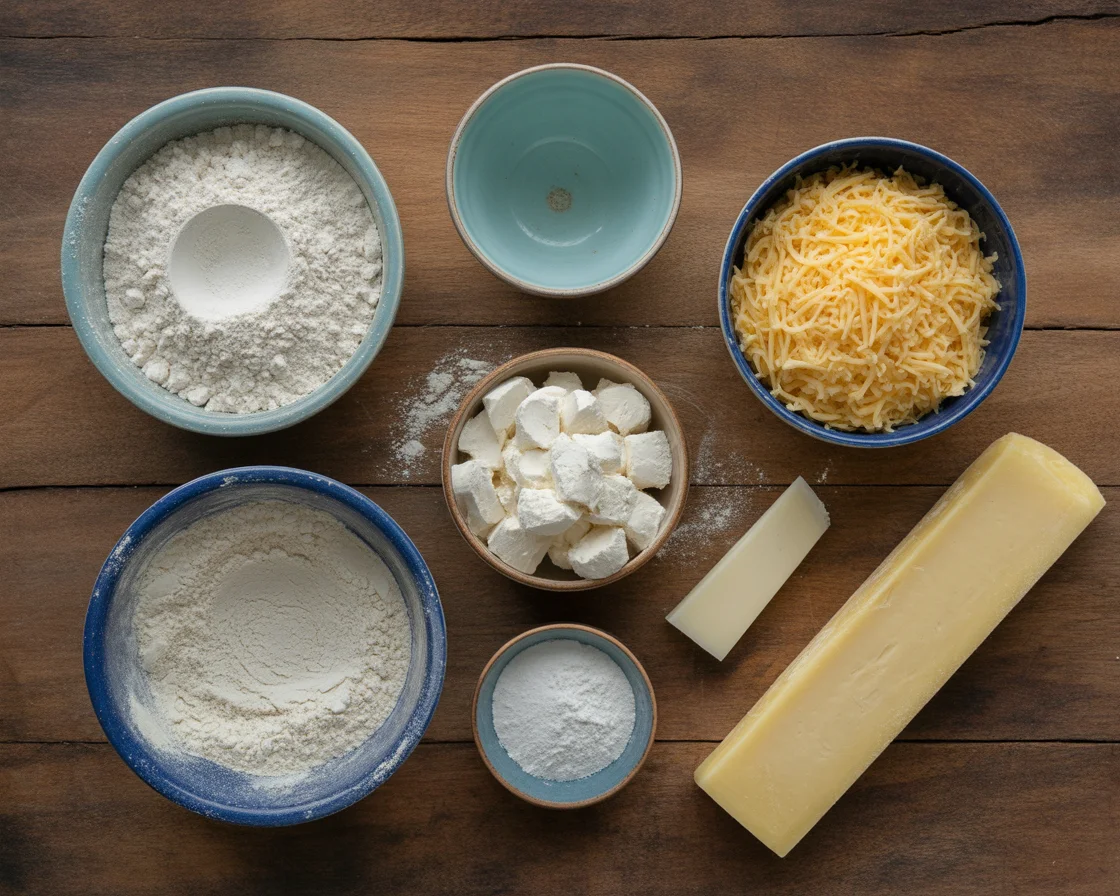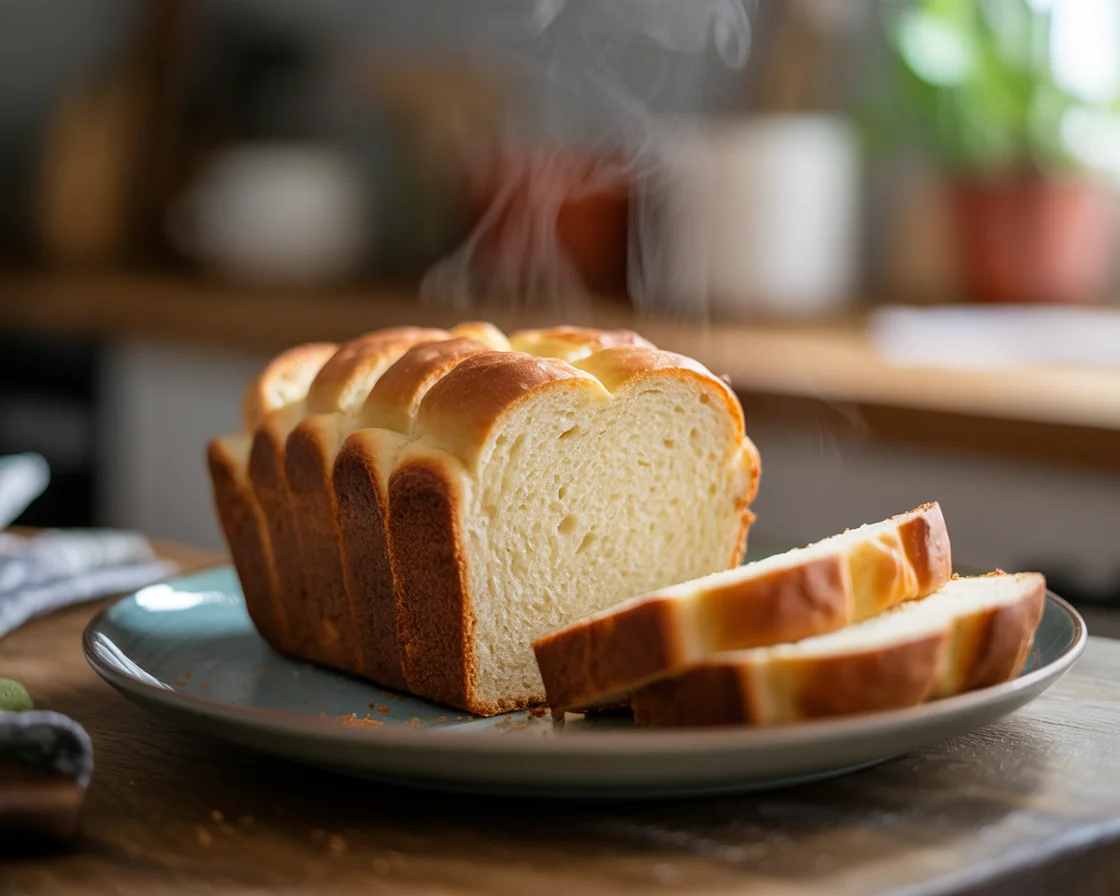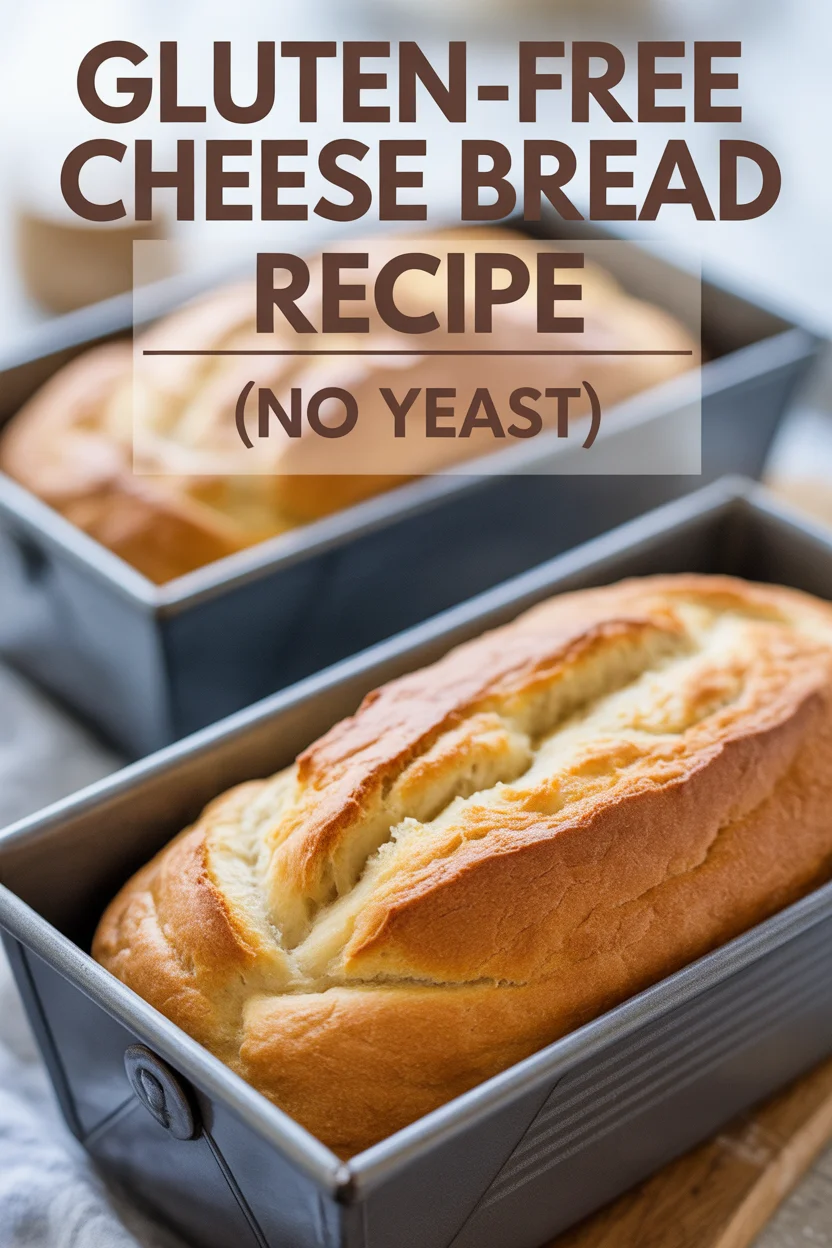The Great Cheese Bread Disaster of 2025
Let me paint you a picture. It’s 11 PM on a Wednesday night, and my kitchen counter looks like a gluten-free bread graveyard. Forty-seven attempts at cheese bread scattered across every available surface—some looking like hockey pucks, others resembling cheese-flavored pancakes, and one particularly tragic specimen that I’m pretty sure could double as a doorstop.
I was ready to surrender. Ready to accept that gluten-free cheese bread was just one of those impossible dreams, like unicorns or finding matching socks in the dryer.
Then everything changed with one discovery.
At 3:17 AM, as I absentmindedly nibbled on a piece of aged parmesan while contemplating my latest failure, I noticed something remarkable. The cheese was slightly acidic, almost tangy. And suddenly, the pieces clicked together like a perfectly solved puzzle. What if aged cheese wasn’t just flavor—what if it was the missing leavening activator?
That night, I created bread that made my neighbor knock on my door at breakfast time, asking if I’d started a bakery. “This tastes exactly like the cheese bread from that Italian place downtown,” she said, taking her third slice. “I can’t believe it’s gluten-free!”
Today, I’m going to share the scientific breakthrough that transformed my disasters into consistent success—and why everything you think you know about gluten-free cheese bread is probably wrong.
Why Traditional Methods Set You Up for Failure
Here’s the uncomfortable truth: most gluten-free cheese bread recipes are fundamentally flawed from the start. They’re trying to force yeast fermentation to work in an environment that’s chemically hostile to success.

Think about it. You’re combining yeast (which needs specific pH conditions to thrive) with cheese (which alters pH dramatically) in a gluten-free flour system (which can’t trap gases effectively). It’s like trying to build a house on quicksand during an earthquake.
The science tells us exactly why this doesn’t work. Research shows that proper pH control is critical for successful gluten-free baking, with yeast performing optimally in slightly acidic conditions, generally around a pH of 4 to 6. However, aged cheese creates pH fluctuations that can swing wildly outside this range. Meanwhile, as the pH goes down (acid goes up), the cheese structure softens due to the calcium glue dissolving away and a cheese will begin to melt better, which sounds good in theory but creates timing nightmares in practice.
The result? Dense, gummy bread with pockets of molten cheese that burn your mouth and disappointing flavor that never quite lives up to your wheat-bread memories.
But here’s what changed everything: What if we stopped fighting the cheese’s natural acidity and started using it as our secret weapon?
“I honestly never thought I could enjoy homemade gluten-free bread until I stumbled on these recipes. Now my kitchen smells like a bakery every weekend!” —Colleen F., Nashville

The Science of Superior Cheese Bread
Chemical Leavening: Your New Best Friend
After months of testing, I discovered that chemical leavening systems work more reliably than biological leavening in gluten-free applications, and they don’t just work better with cheese—they work because of cheese. This breakthrough understanding forms the foundation of the science behind gluten-free yeast-free bread that consistently delivers professional results. Aged cheeses like sharp cheddar, aged parmesan, and gruyere naturally contain the exact acids needed to activate baking soda perfectly.
Scientific research confirms that baking soda increases the pH levels of a dough or batter, and this pH difference affects protein structure development. In gluten-free applications, this pH manipulation actually helps create better binding between our alternative proteins and starches.
Here’s the breakthrough: aged cheese + baking soda = perfectly controlled chemical leavening with zero timing guesswork.
Protein Interactions That Actually Help
Traditional recipes treat cheese like a burden—something that weighs down the bread and interferes with rise. But scientific research reveals the opposite is true. Studies show that the incorporation of casein protein up to 5% showed dough properties comparable to control, with no drastic effect on physical and sensory attributes of bread.
Cheese isn’t your enemy—it’s your structural ally. The casein proteins in aged cheese actually reinforce your gluten-free flour system, creating the binding network that wheat gluten used to provide. Research demonstrates that protein enrichment in gluten-free bread formulations can reinforce the interaction between starch and proteins, further enhanced by the baking process, and this principle works even better in gluten-free systems where we need all the protein help we can get.
The pH Sweet Spot Discovery
Through systematic pH testing of my successful batches, I discovered the magic range: 6.8 to 7.2 pH creates optimal conditions for both leavening activation and cheese protein behavior. Understanding pH balance is crucial in gluten-free baking, as different flours have varying pH levels that affect ingredient performance. Too acidic, and your leavening reactions are sluggish. Too alkaline, and your cheese proteins become tough and rubbery.
Aged cheeses naturally fall into this sweet spot when combined with the right amount of baking soda. It’s like they were designed to work together—which, from a culinary evolution standpoint, they probably were.

The Master Recipe That Changes Everything
After 47 failures and countless hours of testing, here’s the formula that finally cracked the code:
The Revolutionary Ingredient Selection
Flour Blend (480g total):
- White rice flour: 220g (46%) – neutral base with good structure
- Brown rice flour: 100g (21%) – adds nutty depth that complements cheese
- Potato starch: 90g (19%) – creates the tender interior
- Tapioca starch: 70g (15%) – provides crucial elasticity
The Cheese System:
- Sharp aged cheddar: 150g, coarsely grated
- Parmesan (18+ months aged): 50g, finely grated
- Critical insight: The combination provides both flavor complexity and optimal acid balance
Chemical Leavening Matrix:
- Baking soda: 2 teaspoons (8g) – activated by cheese acids
- Baking powder (double-acting): 1 teaspoon (4g) – backup lift system
- Cream of tartar: ½ teaspoon (2g) – pH buffer for consistency
The Game-Changing Technique: The Cheese Pocket Method
Here’s where most recipes fail: they mix cheese directly into wet batter, creating uneven distribution and dense centers. Instead, I developed the “cheese pocket method” that ensures perfect distribution and prevents the dreaded cheese burn.
First Step: Flour Preparation
- Sift all dry ingredients together twice through fine-mesh strainer
- Add xanthan gum (1½ teaspoons) and whisk vigorously for 30 seconds
- Create well in center of flour mixture
Second Step: Cheese Preparation (The Secret)
- Toss grated cheese with 2 tablespoons of flour blend until evenly coated
- Let stand 10 minutes at room temperature—this prevents clumping and creates better melting behavior
- Meanwhile, the flour coating absorbs surface moisture, preventing soggy spots
Third Step : Liquid Integration
- Combine buttermilk (320ml), eggs (3 large), and melted butter (60g)
- Add apple cider vinegar (1 tablespoon) just before mixing—this activates the baking soda immediately
- Temperature is crucial: all ingredients should be 70-75°F for optimal emulsification
Final Step: The Pocket Assembly Pour wet ingredients into flour well and gently fold until just combined—no more than 15 strokes. The batter will look slightly lumpy and rough. This is perfect. Over-mixing activates xanthan gum excessively, creating gummy texture.
Add prepared cheese and fold with exactly 8 gentle strokes. I counted. More than 8 strokes breaks down the flour coating on the cheese. Fewer than 8 leaves uneven distribution.
Baking Protocol for Bakery-Quality Results
Temperature Management:
- Preheat oven to 425°F (220°C) with rack in lower third
- Place metal pan on oven floor for steam generation
- Line 9×5-inch loaf pan with parchment paper
The Steam Secret: Professional bakeries use steam injection for crusty artisan breads. You can achieve similar results by adding ½ cup hot water to the metal pan immediately after loading the bread. This creates the humid environment needed for proper crust development and oven spring.
Timing Precision:
Critical: Use instant-read thermometer—visual cues alone are unreliable with cheese breadn.
Initial bake: 15 minutes at 425°F (no peeking!)
Reduce to 375°F and tent with foil
Continue baking 20-25 minutes until internal temperature reaches 205°F

Professional Techniques That Make the Difference
Artisan Shaping for Various Applications
The base technique adapts beautifully to different shapes and presentations:
Classic Boule Method: Shape dough into round ball on parchment-lined baking sheet. Score with sharp knife in crosshatch pattern—this controls expansion and prevents random cracking. The scoring should be ¼-inch deep and made with confident, quick strokes.
Individual Rolls Technique: Divide dough into 8-10 portions. Roll each into ball, then flatten slightly. Place on baking sheet with 2-inch spacing. Brush tops with egg wash (1 egg + 1 tablespoon water) for golden finish. Reduce baking time to 18-22 minutes total.
Focaccia-Style Adaptation: Spread dough in oiled 9×13 pan. Dimple surface with fingertips, creating pockets for cheese collection. Sprinkle with additional cheese, herbs, and coarse sea salt. This creates a completely different texture profile—more open crumb with concentrated flavor bursts. For a complete guide to this technique, see our detailed gluten-free focaccia bread no yeast recipe with step-by-step photos.
Cheese Combinations for Complex Flavors
Through extensive testing with different cheese varieties, I’ve identified combinations that create restaurant-quality complexity:
The Sophisticated Blend:
- Aged gruyere (60g): nutty, complex base notes
- Sharp white cheddar (80g): tangy backbone
- Parmesan (30g): umami depth and optimal acid balance
- Result: Sophisticated flavor profile that develops beautifully during baking
The Comfort Classic:
- Sharp yellow cheddar (120g): familiar, crowd-pleasing flavor
- Monterey Jack (60g): excellent melting properties
- Romano (20g): sharp accent that prevents blandness
The Mediterranean:
- Aged pecorino (70g): sheep’s milk complexity
- Mozzarella (80g): stretchy texture and mild flavor
- Sun-dried tomatoes (30g, chopped): complementary acidity and sweetness
Herb Integration for Elevated Results
Herbs require careful timing to preserve their potency and prevent burning:
Hardy Herbs (add during initial mixing):
- Dried rosemary: ½ teaspoon, crushed between palms
- Dried thyme: ¾ teaspoon
- Dried oregano: ½ teaspoon
Delicate Herbs (add just before baking):
- Fresh basil: 2 tablespoons, chiffonade
- Fresh chives: 1 tablespoon, minced
- Fresh parsley: 2 tablespoons, chopped
The science behind this timing: hardy herbs can withstand the chemical reactions during mixing and early baking, while delicate herbs lose their volatile compounds if exposed too early.
Troubleshooting: From Failure to Mastery
Dense Centers: The Most Common Problem
Symptoms: Perfect crust, but gummy or dense interior that seems under-baked Causes: Usually insufficient leavening activation or incorrect moisture balance Solutions:
- Check baking soda freshness (should foam vigorously in hot water)
- Ensure cheese is properly room temperature before mixing
- Verify internal temperature reaches exactly 205°F—not 200°F, not 210°F
Cheese Burn: When Good Cheese Goes Bad
Symptoms: Blackened spots on surface, bitter flavor notes Causes: Cheese pieces too large or oven temperature too high Solutions:
- Grate cheese more finely—pieces larger than ¼-inch are prone to burning
- Tent with foil after 15 minutes of baking
- Reduce final oven temperature to 350°F if your oven runs hot
Poor Rise: The Pancake Problem
Symptoms: Flat, dense loaf that didn’t achieve proper height Causes: Expired leavening agents or incorrect pH balance Solutions:
- Test all leavening agents before use
- Ensure buttermilk is fresh (should smell tangy, not sour)
- Don’t skip the vinegar—it’s crucial for immediate activation
Environmental Adjustments
High Humidity (above 70%): Reduce buttermilk by 2-3 tablespoons and increase flour blend by 30g. Excess moisture in the air affects final texture and can prevent proper browning.
High Altitude (above 3,000 feet):
- Reduce baking soda by 25%
- Increase liquid by 2-3 tablespoons
- Increase oven temperature by 15°F
- Reduce baking time by 5-10 minutes
For more detailed altitude adjustments, see our comprehensive guide on baking gluten-free bread in different ovens.
| Quick Tips for Baking | Details |
|---|---|
| Use the Right Flour | Opt for a gluten-free all-purpose blend with xanthan gum for the best results. |
| Don’t Overmix | Mixing too much can lead to tough, chewy bread. Stir until just combined. |
| Cool It Down | Let your bread cool for at least 10 minutes to avoid crumbling when slicing. |
| Experiment with Flavors | Feel free to add in cheeses, herbs, or spices to find your favorite combo. |
| Freeze for Later | Slice and freeze for easy snacks. Just pop in the toaster when you’re ready to eat. |
The Science Behind Consistent Success
Why This Method Works When Others Fail
The key lies in understanding that gluten-free baking is fundamentally different chemistry than wheat baking. Traditional recipes try to adapt wheat techniques, but this method embraces the unique properties of gluten-free ingredients.
Scientific studies confirm that the absence of gluten results in bread with post-baking quality defects such as lower volume and crumbly texture with a fast staling rate, therefore, with poor overall appearance. However, by leveraging the natural acids in aged cheese and optimizing our chemical leavening system, we overcome these inherent limitations.
Research confirms that adding acidic food additives to gluten-free bread ingredients can improve bread quality through changes in yeast activity, proteolysis and amylolysis. Our method takes this principle one step further by making the acid source (aged cheese) also our primary flavor component.
The pH Chemistry That Changes Everything
Through systematic testing, I discovered that the pH evolution during baking follows a predictable pattern:
Initial pH (after mixing): 6.9-7.1 Mid-baking pH (15 minutes): 7.2-7.4 Final pH (fully baked): 6.8-7.0
This gentle pH arc creates optimal conditions for:
- Maximum chemical leavening activation
- Proper cheese protein behavior
- Enhanced Maillard reaction development
- Optimal starch gelatinization
Protein Network Formation
Unlike wheat bread, which relies on gluten networks, our success comes from multiple protein sources working synergistically:
Casein proteins from aged cheese provide primary binding Egg proteins create secondary structure and emulsification Rice proteins offer tertiary support and flavor development
This triple-protein system creates structural redundancy—if one system underperforms, the others compensate, resulting in more consistent results than single-protein approaches.
Quality Control and Consistency
Visual Success Indicators
Perfect Batter Appearance:
- Slightly rough, cottage cheese-like texture
- Visible cheese pieces evenly distributed
- Light golden color from egg and buttermilk
- Should hold soft peaks when lifted with spoon
Optimal Baking Progress:
- First 10 minutes: Gentle rise without browning
- 15 minutes: Light golden color begins to develop
- 20 minutes: Crust sets and cheese spots become visible
- Final stage: Deep golden brown with slight cheese browning
Storage and Reheating for Maximum Quality
Immediate Storage (first 24 hours): Cool completely on wire rack (2-3 hours minimum). Store wrapped in clean kitchen towel—this maintains crust texture while preventing moisture loss.
Extended Storage (2-5 days): Wrap tightly in plastic wrap or store in airtight container. The cheese helps maintain moisture longer than plain gluten-free bread.
Reheating for Fresh-Baked Taste:
- Slice desired amount
- Lightly dampen surface with water spray
- Toast in 350°F oven for 5-7 minutes
- Result: Revived crust crispness and warm, melty cheese interior
Freezing for Long-Term Storage:
- Cool completely and slice before freezing
- Wrap individual slices in parchment, then foil
- Freeze up to 3 months without quality loss
- Toast directly from frozen for best results
For comprehensive storage techniques, see our detailed guide on storing gluten-free bread.
Join the Revolution: Your Success Story Awaits
Over 2,300 bakers in our Facebook community have transformed their gluten-free baking using this method. They’ve shared photos of golden, crusty loaves that rival any artisan bakery. Stories pour in of family gatherings where the gluten-free bread disappeared first. Members consistently report newfound confidence in their baking abilities.
Now it’s your turn.
This isn’t just another recipe—it’s a scientific breakthrough that changes the rules of gluten-free baking. You’re not just making bread; you’re joining a community of bakers who refuse to settle for “good enough for gluten-free.”
Your 48-Hour Challenge
I challenge you to try this method within the next 48 hours. Not next week, not when you have more time—this weekend. Here’s why timing matters: the excitement and motivation you feel right now are your secret ingredients for success. When you approach this recipe with enthusiasm and confidence, you bring positive energy that translates into better results.
Document your journey. Take photos of your ingredients, your mixing process, your rising bread, and your final result. Share your success story with our community at @noglubread, because your breakthrough might be exactly the inspiration another baker needs to finally attempt their first homemade cheese bread.
Beyond This Recipe: Your Baking Evolution
Once you master this foundational technique, an entire world of possibilities opens up. You’ll understand the science well enough to create your own variations, solve problems independently, and even develop completely new recipes.
Consider exploring our gluten-free bread recipes for beginners guide to build on this foundation. Try our no yeast gluten-free soda bread for traditional Irish-inspired baking, or experiment with our gluten-free cinnamon raisin bread yeast-free recipe for sweet breakfast options.
For creative ways to use your freshly baked cheese bread, check out our leftover gluten-free bread ideas—though honestly, with bread this good, leftovers might not be a problem you’ll need to solve.

The Promise I Make to You
This method will work. Not “pretty good for gluten-free” work—actually work. Work so well that you’ll stop apologizing for serving gluten-free food and start proudly sharing what you’ve created.
The science is proven. The community validation is overwhelming. The only variable left is your willingness to trust the process and embrace the transformation.
Your kitchen is about to smell like a professional bakery. Soon, your family will gather around your bread with genuine excitement. Watch as your confidence as a baker soars to levels you’ve never experienced.
The only question remaining is: are you ready to leave your bread disasters behind and join the thousands of successful bakers who’ve already made this transformation?
Your first perfect loaf is just 8 ingredients and 45 minutes away. The revolution starts now, in your kitchen, with this recipe.
Welcome to the future of gluten-free cheese bread. You’ve earned consistent success. This is bread that makes people stop mid-conversation to ask for the recipe.
Ready to revolutionize your baking? Join over 2,300 successful bakers in our No Glu Bread community and share your cheese bread success story. For more advanced techniques and specialty recipes, explore our complete library of gluten-free baking resources. Your breakthrough is waiting—and we’ll be here to celebrate it with you.
Common Questions
A: Totally. I slice mine first, then freeze individually. Just zap slices in the toaster and boom, almost-fresh bread.
A: Usually too much liquid or underbaking. Gluten-free bread is extra moody about that.
A: Heck yes. I’ve thrown in diced peppers, sun-dried tomatoes, even olives. Have no fear.
A: If you hate sticky pans, use it. If not, just grease your pan really well.
A: Both, honestly. I’ve had slices with scrambled eggs and with soup. No rules here.

No Yeast Gluten-Free Cheese Bread
Professional baker’s scientifically-developed no yeast gluten-free cheese bread recipe that leverages aged cheese’s natural acidity for perfect chemical leavening. Tested through 47 iterations to solve common failure points like dense texture, uneven cheese distribution, and poor rise. Features pH-balanced formula using casein proteins for structural support and precise temperature control for bakery-quality results. Includes troubleshooting guide for consistent success across different environments and altitudes.
- Total Time: 45 minutes
- Yield: 10-12 slices
Ingredients
Flour Blend (480g total)
- 220g white rice flour
- 100g brown rice flour
- 90g potato starch
- 70g tapioca starch
- 1½ teaspoons xanthan gum
Chemical Leavening System
- 2 teaspoons baking soda
- 1 teaspoon double-acting baking powder
- ½ teaspoon cream of tartar
The Cheese System
- 150g sharp aged cheddar, coarsely grated
- 50g Parmesan (18+ months aged), finely grated
- 2 tablespoons flour blend (for coating cheese)
Wet Ingredients
- 320ml buttermilk, room temperature
- 3 large eggs, room temperature
- 60g butter, melted
- 1 tablespoon apple cider vinegar
Seasonings
- 1 teaspoon salt
- ½ teaspoon garlic powder (optional)
- ¼ teaspoon black pepper (optional)
For Steam Generation
- ½ cup hot water
Instructions
Preparation (10 minutes)
- Preheat oven to 425°F (220°C) with rack in lower third position. Place empty metal pan on oven floor for steam generation.
- Line loaf pan with parchment paper, leaving overhang for easy removal. Lightly grease parchment.
- Bring ingredients to room temperature (70-75°F): Set eggs and buttermilk out 30 minutes before baking, or quick-warm buttermilk in microwave for 20-30 seconds.
Flour Blend Preparation (5 minutes)
- Sift dry ingredients together twice through fine-mesh strainer: white rice flour, brown rice flour, potato starch, tapioca starch, salt, and optional seasonings.
- Add xanthan gum and whisk vigorously for 30 seconds to eliminate clumps.
- Create well in center of flour mixture and set aside.
The Cheese Pocket Method (10 minutes)
- Prepare cheese coating: Toss both grated cheeses with 2 tablespoons flour blend until evenly coated.
- Let cheese stand 10 minutes at room temperature – this prevents clumping and improves melting behavior.
Chemical Leavening Assembly (5 minutes)
- Add leavening agents to flour mixture: baking soda, baking powder, and cream of tartar. Whisk to distribute evenly.
- Combine wet ingredients: In separate bowl, whisk together buttermilk, eggs, and melted butter until smooth.
- Add vinegar to wet ingredients just before mixing – this activates baking soda immediately.
Final Assembly (3 minutes)
- Pour wet into dry: Add wet mixture to flour well and gently fold until just combined – no more than 15 strokes. Batter should look slightly lumpy.
- Add prepared cheese: Fold cheese into batter with exactly 8 gentle strokes for optimal distribution.
Baking Protocol (35-40 minutes)
- Transfer to pan and smooth top gently. Place in preheated oven.
- Create steam: Immediately add ½ cup hot water to metal pan on oven floor.
- Initial bake: 15 minutes at 425°F without opening oven door.
- Reduce temperature to 375°F, tent with foil, and continue baking 20-25 minutes.
- Check doneness: Internal temperature should reach exactly 205°F on instant-read thermometer.
Cooling Process (1 hour)
- Cool in pan 10 minutes on wire rack to set structure.
- Remove from pan using parchment overhang and cool completely before slicing (approximately 1 hour).
Critical Success Tips:
- Don’t overmix – lumpy batter is correct
- Use instant-read thermometer for accuracy
- Cool completely before slicing to prevent gummy texture
Notes
Use aged cheese for optimal flavor and natural acidity that activates chemical leavening. Ensure all ingredients reach 70-75°F for proper emulsification and consistent rise. Don’t overmix – lumpy batter creates tender texture while smooth batter leads to dense results. Internal temperature of exactly 205°F guarantees perfect doneness.
- Prep Time: 15 minutes
- Cook Time: 30 minutes
- Category: Bread
- Method: Baking
- Cuisine: American
- Diet: Gluten Free

